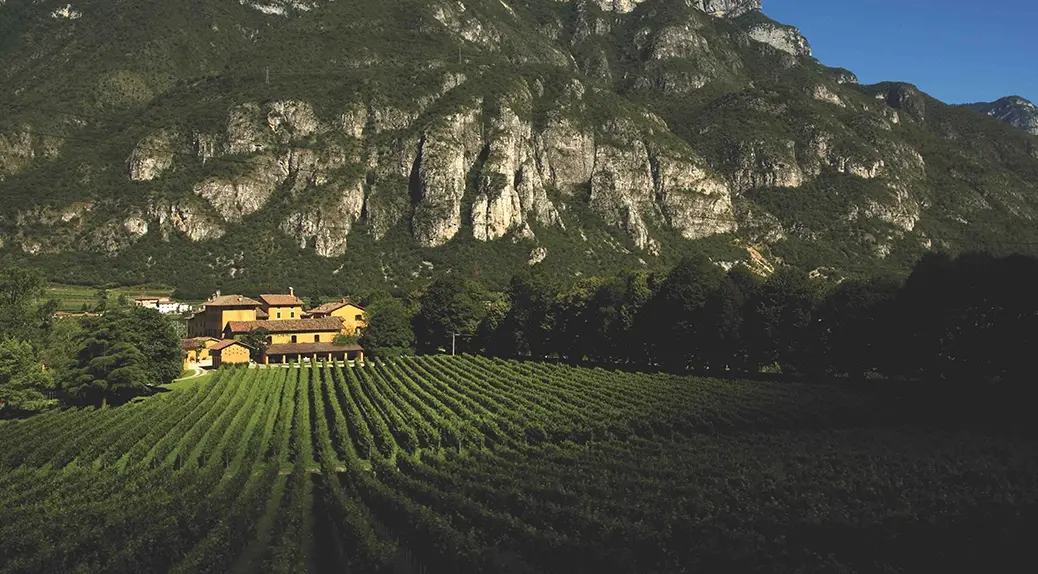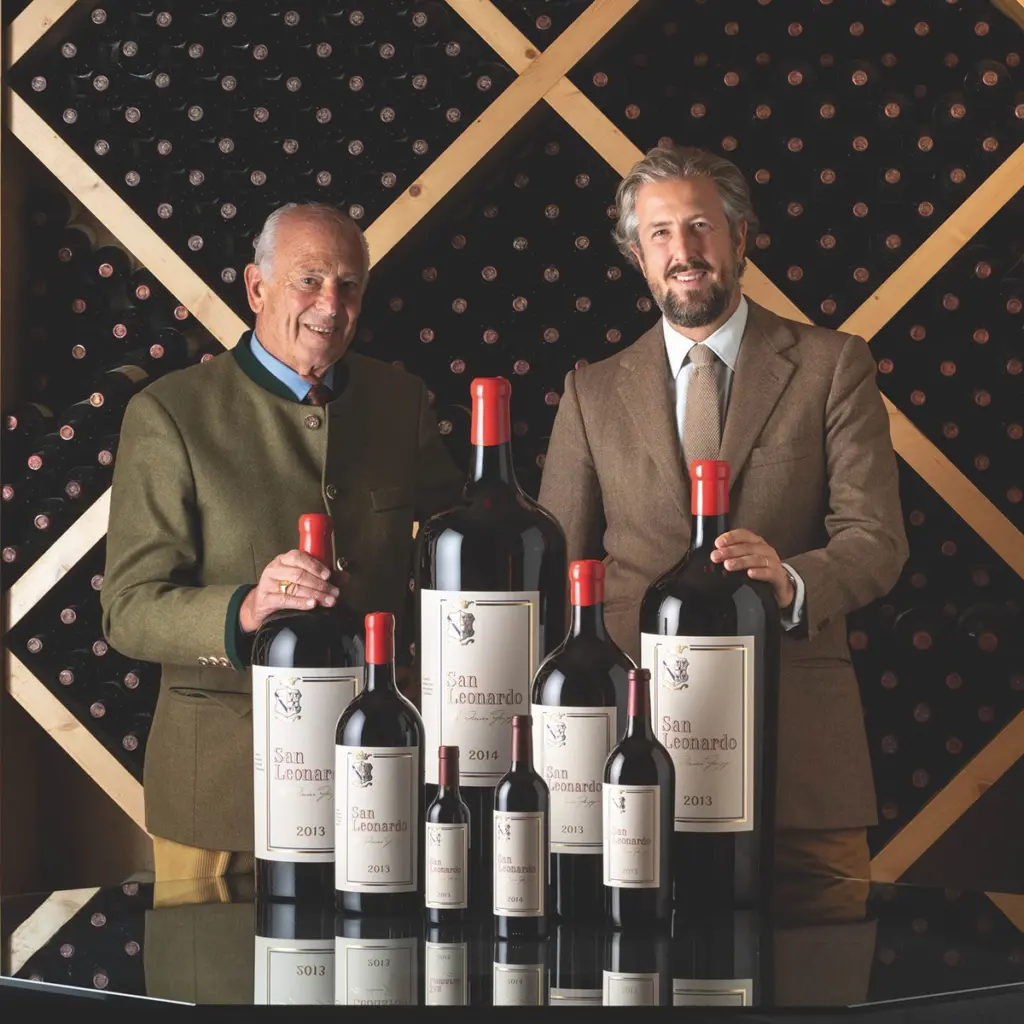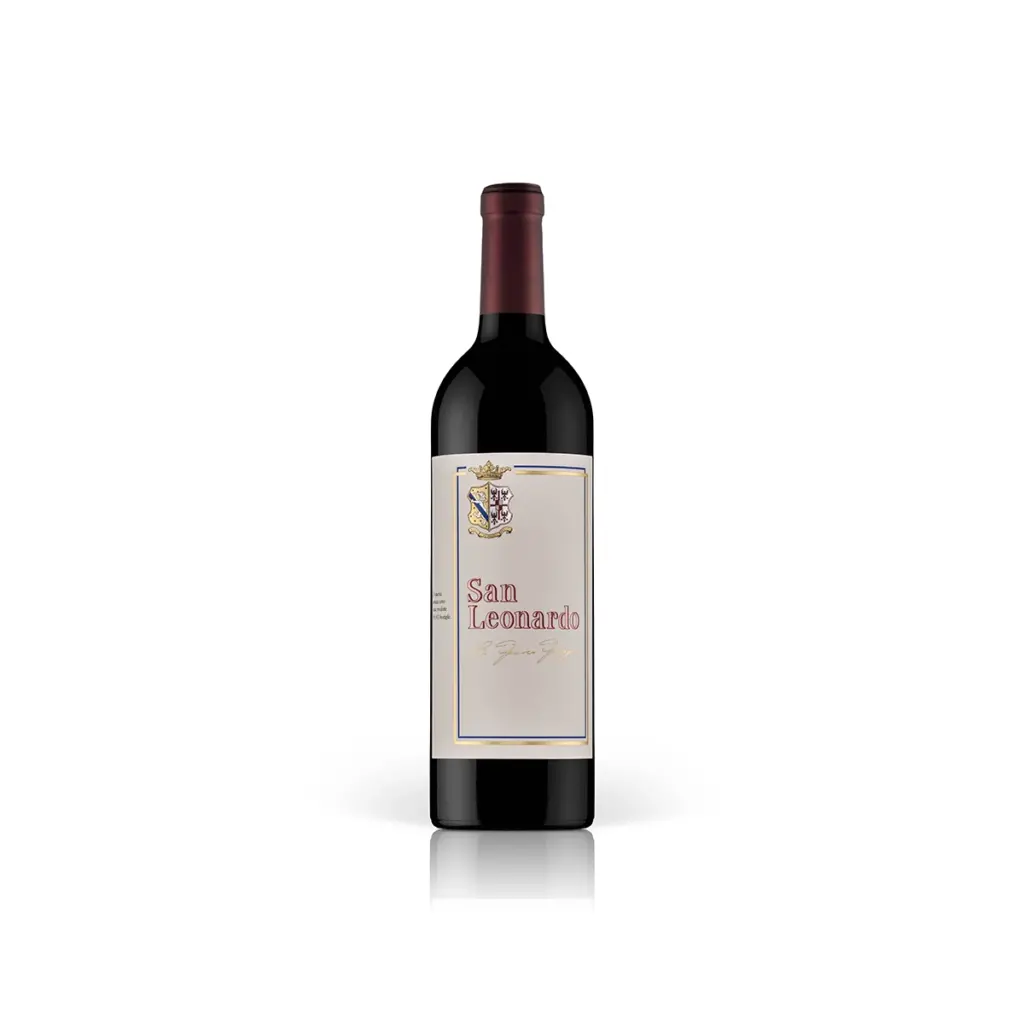
Its varietal make-up may be unfashionable amid the contemporary fixation on local grapes. But Tenuta San Leonardo’s Cabernet and Carmenère-led Trentino red is without question one of Italy’s finest wines.
Not far from the limpid waters of Lake Garda in the northeast of Italy, the 300ha (750-acre) Tenuta San Leonardo shelters at the foothills of the Dolomites. The San Leonardo estate has a history that stretches back more than 1,000 years. It is traversed by the ancient Via Claudio Augusta that once brought Roman legions back to the valley of the Po from the rich provinces of Rhaetia. Along this road there can still be seen an ancient, gnarled chestnut tree that, according to legend, provided shelter for the devout and beautiful 6th-century Lombard queen Theodalinda on her way to be married to King Autari in the monastery that has since become San Leonardo.
More recently, what is now the autonomous province of Trentino was the southernmost rim of the Austrian Tyrol until it was annexed by the Kingdom of Italy in 1919. In the 19th century, San Leonardo, then known as Château St Leonard, produced award-winning Riesling and “Borgogna” wines for the Habsburg Austrians. During World War I, the Liberty-style villa was bombed just half an hour after the family escaped. After the war, which decimated the population, the present owner’s grandmother, Gemma de Gresti, devoted her life to the search for lost soldiers and to bringing them back to their families. During World War II, the family had to leave San Leonardo again when the Germans set up barracks that were later occupied by the Italians and then by the British.
The present owner of Tenuta San Leonardo, Marchese Carlo Guerrieri Gonzaga, inherited the estate from his father, Anselmo, in 1974. Now the next generation, represented by Carlo’s son—also named Anselmo after his grandfather—is taking over, but Anselmo credits his father, Carlo, with having invented the modern San Leonardo wine, which was launched in 1982. Carlo Guerrieri Gonzaga trained as an enologist in Lausanne, an unusual career decision at the time. Upon graduating in 1962, however, Carlo learned that his father had just hired another enologist a year younger than he was to run the family estate. Carlo therefore became an independent wine consultant in Tuscany and worked for five years for his grandfather’s friend, Mario Incisa della Rocchetta, the creator of Sassicaia, before changing professions to join his brother in the far more profitable cement business.
Working with Mario Incisa instilled in Carlo a passion for the wines of Bordeaux, the region that for his generation was the epitome of French wine and the manifest progenitor of fine wine. When Carlo took over the San Leonardo estate after his father’s death in 1974, he planted Cabernet Sauvignon and, with the assistance of Sassicaia’s renowned consultant enologist Giacomo Tachis, set out to create his own Cabernet-dominated (around 60 percent) blend. There was a difference, however. Trentino, thanks to the Habsburg Austrians, already had a long tradition of growing French grape varieties, which had been introduced at San Leonardo in the 19th century.
In particular, there were historic plantings of Cabernet Franc dating back to the 1870s. This historic Cabernet Franc became the secondary component (around 30 percent) of San Leonardo, creating a blend that would have been closer to the Right Bank of Bordeaux than the Left. What Carlo did not realize until the late 1990s, however, was that what the family had always believed to be Cabernet Franc was in fact Carmenère. It was only when he wanted to increase the plantings of Cabernet Franc and ordered new vine material directly from France that Carlo saw the difference and realized the mistaken identity.
The dazzling success of Super-Tuscans, and Sassicaia in particular, has legitimized Bordeaux varieties in Italy. By now, Tuscany is recognized to be as much a Cabernet Sauvignon terroir as Napa or Stellenbosch. This success, however, has had a polarizing effect, and there has been what one might call a kind of “counter-reformation” in favor of Italy’s indigenous, local varieties. The zealous fervor of this quasi-religious re-reappraisal has obscured all else that might contextualize Italian wines, and in particular the presence of French grape varieties on the Italian peninsula long before Bolgheri became famous for wine.
There is now a common disdain for French grape varieties based on the mistaken assumption that, except in some favored parts of Tuscany, only Italy’s so-called local varieties are legitimate. Historic vineyards and old vines are swept aside by the craze for the newly fashionable local varieties, even in places where they may have never existed before. When Anselmo, Carlo’s son, started working for his father a decade ago, he noticed this trend and thought it might make their wine more popular if they added a small proportion of the local Teroldego to the blend. When he suggested this to his father, he was met with a stony silence and told to “go back to the office.” The idea was never raised again.

Safeguarding a unique identity
San Leonardo is one of Italy’s great wines. The discovery that the original Cabernet Franc was actually Carmenère not only explains why the vineyards turn a deep carmine hue every fall but also elucidates the innate character of the wine, with its marked smoky paprika and green-olive notes, and the highly structured tannins, which have an almost military rigidity that is miles away from the hedonistic Bordeaux blends of Tuscany. The flavors of Carmenère seem impossible to miss now that we know what it is, which (to the chagrin of blind tasters) is often the case with wine.
Anselmo is focused now on reinforcing the identity of San Leonardo by reintroducing the pergola system, which was being phased out by his father but is not only traditional in the region but also helps keep alcohol levels down, preserving in the wines their admirable Old World balance and restraint and even a hint of resinous greenness that was once, but is no longer, an attribute of classic Bordeaux. The challenge for a great estate like this is to stay authentic and individual, rather than becoming too standardized as production rises and it seeks wider distribution.
Anselmo is reinforcing the Carmenère identity by carrying out proprietary vine selections propagated for him by a local nursery. This kind of highly detailed, laborious, and costly attention to detail, which until recently would never have been contemplated by a small estate in Italy, is an example of how the next generation is prioritizing quality and is determined to preserve and reinforce the estate’s unique identity and history—in this case, with the salvage of old clonal material that is now treasured as a precious relic of an older, very different “Bordeaux” that is no longer to be found at all widely in Bordeaux itself.
Wine is always a phenomenon precariously balanced between the past, the future, and the present. The past is its history. The future is how it develops in the bottle and how it will be remembered. The present is the most unpredictable variable of all. It is the moment when the bottle is opened and subjected to the unpredictable influence of inner moods, external emotions, and whatever’s on the menu. San Leonardo is the leading estate of its region and one of the most admired in Italy. Not by chance was it the wine served at the glittering high-society Circolo della Caccia ball in Rome in 2022.
In the USA and UK, however, it is known only to a few avid collectors. At a tasting at Trivet restaurant in London in October 2022, Berkmann Wine Cellars announced that it was taking over the distribution of San Leonardo in the UK. The time is long overdue for this great insider’s secret to move out of the shadows and into the sunny uplands. What was evident at the Berkmann tasting was that San Leonardo has come of age and should now be recognized by all serious collectors as one of Italy’s classics, as well as a wine that ages gracefully over the long term.
The Berkmann tasting left no doubt in anyone’s mind that San Leonardo is well worth seeking out. The younger vintages already offer immediate pleasure, but what the older vintages demonstrate is that this is a wine worthy of long cellaring. Another thing to remember is that Trentino has a different climate from Tuscany, with a high diurnal range. Some of the vintages that are most impressive here are lesser vintages for the rest of Italy, which means that they can be overlooked by those following Bordeaux or Tuscany vintages as a yardstick. This is a wine that shows best, it seems to me, in cooler vintages.
Tasting San Leonardo
Trivet, London; October 18, 2022
2017 San Leonardo IGT Vigneti delle Dolomiti
Beautiful perfume of old musk roses, with ripe plummy fruit that speaks of a hot summer that was, however, chequered with August hailstorms. The intense concentration of flavor is thanks to a very small yield, down more than 30 percent because of the hail. The classic San Leonardo blend here is 60 percent Cabernet Sauvignon, 30 percent Carmenère, and 10 percent Merlot. This is a full-bodied vintage, with flavors of ripe plums, wild blueberry, gingerbread, chestnuts, cinnamon, and dark morello cherry at the core. The noteworthy acidity and firm tannins feel like stiff velvet, giving a tightly knit and substantive texture. The alcohol at 13.5% contributes richness and depth, but with restraint. Spicy notes of nutmeg, allspice, star anise, and cumin unfold on the long finish. 2022–60. | 96
2015 San Leonardo IGT Vigneti delle Dolomiti
Vivid black-cherry fruit, with grainy and polished tannins reminiscent of a glazed Sachertorte. Intense and deep, with a sweet vegetal note of sun-dried tomato and the roasted red capsicum that is a classic marker for Carmenère. Notes of spicy and smoky paprika and a floral note that calls to mind a bouquet of late-summer roses, pink peonies, and the image of black tulips. The tannins are well endowed and supple. This was an excellent, problem-free vintage, which will continue to give great enjoyment over many years and will develop over time into something truly profound. 2025–55. | 93
2011 San Leonardo
IGT Vigneti delle Dolomiti
A beautiful, translucent, intense ruby color conveys lightness and intensity mirrored by the nose. Spicy cayenne with wafts of dried tobacco leaf and sweet, earthy flavors of roast pumpkin, glazed carrots, smoky, charred roast meat, late-ripening persimmon, and dried orange rind. Firm grainy tannins, strong acid backbone, and a balanced ABV of 13.5%. Intense and complex on the finish, with lingering notes of pipe smoke and fragrant autumn leaves. The long maceration and up to three daily pump-overs gives this wine its characteristic substance and resilience. This was the first vintage for which San Leonardo became fully organic. 2022–50. | 97

2006 San Leonardo IGT Vigneti delle Dolomiti
A wet vintage, but the wine emerged pristine, thanks to cool and sunny weather at harvest, which amplified the diurnal range. Floral notes of violet and peony, with dark-cherry juice, blueberry, and tart red cranberry at the core. Exotic hint of Turkish cigarettes, yarrow root, and sharp green mustard. There are the signature Carmenère vegetal tones of tomato leaf, with earthy poppy seed, meaty beef broth, and umami strains of soy sauce. Structured acidity with distinct edges, and tight-grained, finely knit tannins, while the long finish also suggests many years of development and enjoyment ahead. 2022–46. | 95
2000 San Leonardo
IGT Vigneti delle Dolomiti
Despite the very dry growing season, this wine displays an elegant, harmonious structure and a meaty savory character like slow-cooked meat ragout, with notes of chocolate and umami. Flavors of tomato leaf, red capsicum, potpourri, savory dried porcini mushrooms, green olive, pickled cornichon, and licorice root. It is dense, with high levels of dry extract. Just the slightest bit hedonistic, the 2000 treads the fine balance required of an elegant, classic profile. 2022–50. | 93
1999 San Leonardo
IGT Vigneti delle Dolomiti
This needs time to unfurl but opens up in the glass with a sweet and joyful aroma of red strawberry and full-blown roses. The fruit is sweet and round on the palate, with baked strawberry and raspberry tart, alongside a hint of bitter, strong espresso and creamy tiramisù. The tannins are firm, but with a fine texture. There are fewer spicy, vegetal, and savory notes than other vintages, a little less complexity and more sweetness, again from a warm vintage with little rain and high temperatures. 2022–38. | 92
1997 San Leonardo
IGT Vigneti delle Dolomiti
The vigorous, blackish ruby color shows no signs of fading, and the wine is still going strong. The aromas are of sandalwood and cigar smoke, with plum and morello-cherry fruit in the background. The classic San Leonardo elements are easily discerned. There are vegetal tomato and tomato-leaf notes, and appetizing umami tastes of meaty Bresaola, with exotic hints of curry leaf and turmeric. This was a very dry vintage, with a cool and sunny harvest, and the wine is concentrated, with a long finish and a firm upright structure of finely knit tannins backed by the animating acidity characteristic of this estate. This wine is still developing and is sure to reward patient cellaring. 2022–38. | 96+
1987 San Leonardo
IGT Vigneti delle Dolomiti
The rowanberry color of this mature wine is intense and beautiful, foreshadowing the astonishing youth and complexity displayed on the nose; here there are aromas of Darjeeling and smoked paprika, then on the palate there are flavors of beetroot, roasted radicchio di Treviso, licorice root, and mouth-tingling Szechuan pepper. Elegantly structured, the tannins are muscular, and there is on the mid-palate an intense sweetness of wild strawberries to lean into and savor. The alcohol is 12.5%. Earthy umami notes of nori seaweed and cashew nuts unfold in the complex, long finish. The overall effect is reminiscent of a great bottle of Bordeaux from the 1960s. This is a truly outstanding wine that gives a real incentive to hold younger vintages of this wine in the cellar until fully mature. 2022–30. | 98






